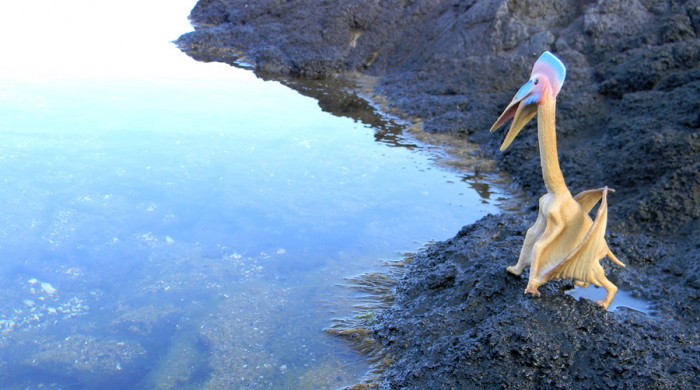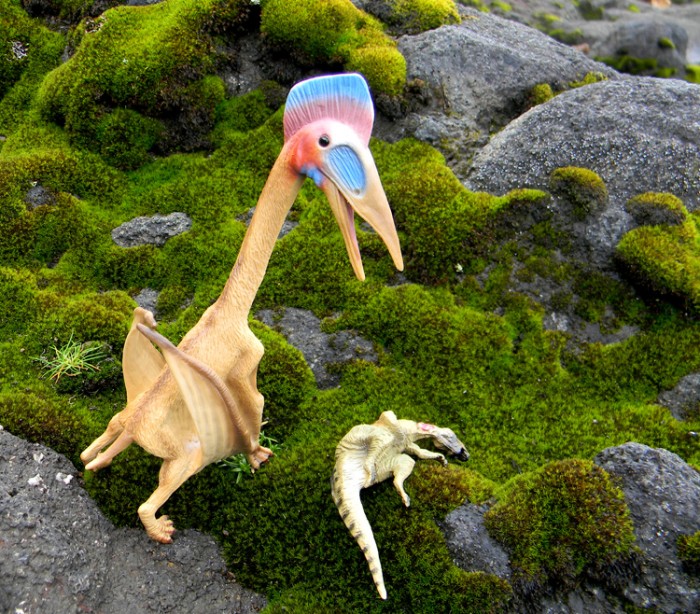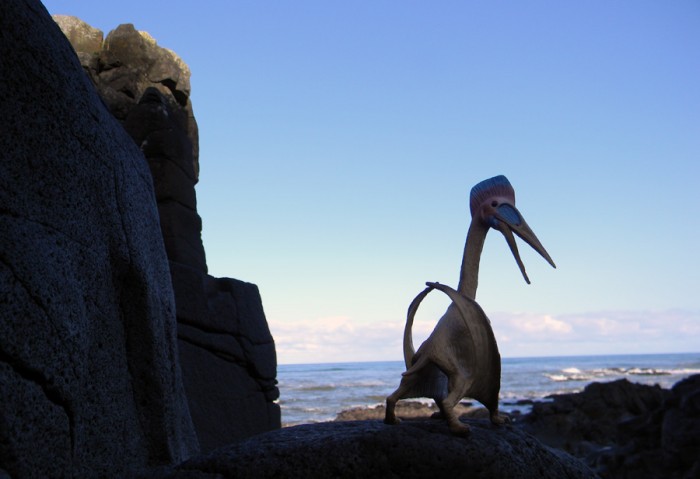Review by Dan, photos by Boki
The CollecA lineup continues its tradition of introducing exotic species to the mass-produced figure market, admirably calling attention to animals that many have never before seen. The 2011 Hatzegopteryx may sound odd, but the appearance of this animal is quite familiar. One quick glance recalls the azhdarchid pterosaurs, known for their lengthy necks and… well, Quetzalcoatlus above all else. Quetzalcoatlus is of course famously known as the largest flying animal ever known to exist. The more recently described Hatzegopteryx achieves notoriety by virtue of its size, which is comparable to ol’ Quetz, possibly even surpassing it. Fragmentary remains make this a difficult competition to judge, much to the chagrin of size fanatics, caught up in some pseudo-Freudian obsession.

Fortunately, we of the Dinosaur Toy Blog are nothing if not mature intellectuals. To be fair, this figure is 15 centimeters high, which seems generous among the company’s standard-size range. Perhaps just as striking is the upright “walking posture,” rarely seen in pterosaur figures which are presumably designed with children’s action-oriented play in mind. There has been recent interest in possible feeding behaviors from this stance as well, so perhaps all is not lost for the little kiddies.

Sometimes the original artwork “inspiring” the figure is all too obvious, but that doesn’t seem to be the case for CollectA’s Hatzegopteryx. Someone has observed the similar “red and blue head on a tan body” design used on Sideshow’s Tupuxuara, but I’m willing to give CollectA the benefit on the doubt on this one. The body has a nice fuzzy texture, and the fenestra pops prominently with that bright blue. The coloration is striking, but not so cartoonish as to completely void the credibility of the figure. Most standard-sized CollectAs utilize this sort of simple design, and given the low price point, most collectors apparently are pleased with it. In fact, the Hatzegopteryx happens to be one of the most popular CollectAs of the year.

CollectA does have an Ornithocheirus coming later in 2011, but despite the WwD-stardom of that species, it would not surprise me if Hatzegopteryx held onto its popularity among collectors. The design is friendly and appealing, the pose is memorable, and the price is hard to argue with.
Disclaimer: links to Ebay and Amazon on the DinoToyBlog are affiliate links, so we make a small commission if you use them. Thanks for supporting us!




[…] Ornithocheirus shot to fame in 1999 when it starred in an episode of the fabulous BBC series Walking With Dinosaurs. Since then, however, scientists have determined that the pterosaur featured was in fact a species of Tropeognathus. The best-known Ornithocheirus species, O. simus, had a respectable wingspan of around five metres, but that was nowhere near the size of giants like Quetzalcoatlus and Hatzegopteryx. […]
[…] model has a verry surprising pose (but it is previously done by collecta); the ‘giant storker’ […]
Se nota que es un pterosaurio carroñero como el Quetzalcotlus,esa ilustración es fantastica porque cuando la vi me gusto mucho.
“Sometimes the original artwork inspiring the figure is all too obvious…”
I think this piece was pretty obviously inspired by Mark Witton’s restoration, seen here: http://scienceblogs.com/tetrapodzoology/Hatzegopteryx%20M.%20Witton%20247%20px.jpg
That also seems to be one of the only restorations of Hatzegopteryx in existence, and certainly the most well known (based on Google image search at least). Not really surprising that they’d use it as the basis for this figure.
Great photos! Great toy! Im curious…what is the ‘dead’ dinosaur toy from? What brand and the like?
Es uno de los más notables reptiles voladores que ha hecho Collecta, esta mucho mejor de lo que aparenta las fotografías, y me impresiono de forma más positiva. Sin embargo me parece de todas maneras un poco infantil y no impresiona tanto como el Rhamphorhynchus de Safari que tiene unos rasgos muchísimo más amenazadores.
De todas formas es el mejor modelo en juguete que se ha hecho de pterodáctylo a cuatro patas.
An interesting review, but most impressed with the photography, after all the fragmentary fossils of this Azhdarchid have been found in strata associated with a coastal environment.